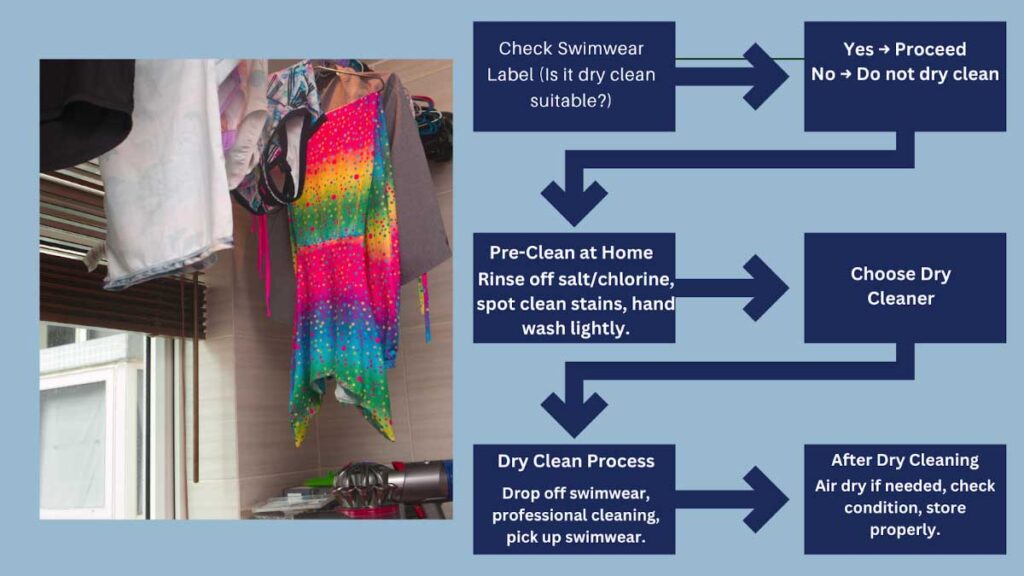
Summer is the season for lounging by the pool, basking in the sun, and making a splash in the waves. But let’s face it—all that fun in the water and exposure to the elements can take a toll on your beloved swimwear. Proper maintenance ensures your bathing suits retain their vibrant colors, stretchy elasticity, and overall longevity.
Many beachgoers fall victim to common swimwear care misconceptions, such as not rinsing after use, using harsh detergents, or tossing suits in the dryer. Say goodbye to those outdated practices! This comprehensive guide will equip you with expert tips for dry cleaning swimwear, allowing you to flaunt your beach style with confidence for seasons to come.
The Do’s of Swimwear Dry Cleaning
Understanding Fabric Types
Before we dive into the dos (and don’ts) of dry cleaning, let’s break down the most common swimwear materials. Swimsuits are typically crafted from synthetic fabrics like nylon spandex, polyester spandex, or neoprene/scuba, all designed to withstand exposure to water, chlorine, and sunlight.
However, each fabric has unique care requirements, so paying close attention to the garment’s label for specific washing and drying instructions is essential.
Choosing the Right Dry Cleaner
Not all dry cleaners are created equal when it comes to handling delicate and specialty fabrics like swimwear. When selecting a dry cleaner for your dry cleaning swimwear needs, look for establishments with experience in caring for activewear, athleisure, or athletic apparel.
Imagine if you’re vacationing in Miami and want to do laundry, consult a reputable dry cleaner in the South Beach area. Don’t be afraid to ask questions about their processes, specifically inquiring about the types of solvents and cleaning agents they use on swimwear. A reputable laundry Miami South Beach cleaner should be transparent and knowledgeable about handling these specialized fabrics.
Preparation Before Dry Cleaning
Before handing over your swimwear to the professionals, there are a few crucial steps to take at home. First and foremost, rinse off any residual saltwater, chlorine, or sunscreen immediately after use. These elements can cause discoloration, fading, and premature wear if left to set in.
Next, hand wash your swimwear in cool water using a mild detergent or a specialized swimwear cleaner. This gentle pre-treatment will help remove any surface dirt, oils, or residue, making the dry cleaning process more effective. Rinsing your swimwear after every use is a simple yet crucial step in prolonging its life and maintaining its vibrant colors.
The Don’ts of Swimwear Dry Cleaning
Avoiding Harsh Chemicals
When it comes to caring for swimwear, harsh chemicals like bleach, fabric softeners, and strong detergents are a definite no-no. These agents can break down the delicate fibers, causing fading, discoloration, and loss of elasticity.
Before entrusting your swimwear to a dry cleaner, make sure they use gentle, pH-neutral solvents and cleaning solutions specifically formulated for synthetic fabrics.
Heat Damage
Excessive heat is a swimwear’s worst enemy. High temperatures from dryers, direct sunlight, or even hot iron settings can wreak havoc on the elastic properties of your swimsuits, leading to misshapen, stretched-out, and damaged pieces.
Always opt for air-drying or low-heat tumble drying, and never iron your swimwear directly. Proper heat management is key to preserving swimwear shape and preventing irreversible damage.
Ignoring Care Labels
It may seem like a no-brainer, but you’d be surprised at how many people overlook the crucial care labels on their swimwear. These tiny tags contain invaluable information from the manufacturer on the best swimwear washing instructions for each specific garment.
Ignoring these guidelines can lead to premature fading, stretching, or even complete fabric disintegration. Take the time to read and follow the care labels to the letter—your swimwear (and wallet) will thank you!
Alternatives to Dry Cleaning
While dry cleaning is an excellent option for maintaining your swimwear, it’s not the only solution. For those seeking a more hands-on approach or looking for eco-friendly swimwear care alternatives, consider these at-home methods:
Hand Washing Techniques
Gentle hand-washing swimwear with a mild detergent or dedicated swimwear cleaner can be just as effective as dry cleaning, especially for lightly soiled or worn pieces. Fill a clean sink or basin with cool water, add a small amount of cleaner, and gently swish your swimwear around.
Avoid twisting, wringing, or agitating the fabric, as this can damage the delicate fibers and cause premature stretching. Rinse thoroughly and lay flat to air dry.
Air Drying
While tossing your swimwear into the dryer may seem like a convenient option, air drying is the better choice for preserving the integrity and longevity of your beachwear. High heat can cause fabrics to shrink, stretch, or lose their elasticity over time, leading to misshapen and ill-fitting suits.
By air-drying your swimwear, you can avoid these potential pitfalls and maintain the color and elasticity of your favorite pieces. This gentle drying method also helps prevent fading and discoloration caused by excessive heat exposure.
To ensure your swimwear air dries properly, follow these simple tips:
- Lay your suits flat on a clean, absorbent towel or drying rack, smoothing out any wrinkles or creases.
- Avoid direct sunlight, as the UV rays can cause fading and fabric degradation over time.
- Ensure adequate airflow by positioning your swimwear in a well-ventilated area, such as near an open window or fan.
- For quicker drying, gently roll or squeeze the excess water from your suits before laying them out to air dry.
Advanced Swimwear Care Tips
Anti-Chlorine Treatment
Chlorine can cause fading, discoloration, and premature deterioration of swimwear fabrics. Combat this by rinsing suits in a vinegar solution after pool use to remove chlorine residue and restore pH balance. You can also invest in specialized chlorine removers or swimwear protectors that break down and eliminate chlorine molecules during the wash cycle.
Spot Cleaning: Immediate Action for Spills and Stains
Act quickly when spills or stains occur to prevent them from setting. Immediately rinse the affected area with cool water. Then, use targeted solutions like mild detergent for sunscreen/tanning oil stains or lemon juice for sweat/deodorant marks. Gently dab or blot the stain, avoiding excessive rubbing that could damage the fabric.
Storage Solutions
When the summer season draws to a close, proper swimwear storage solutions are essential for ensuring your beachwear stays in pristine condition until next year.
First, make sure your swimsuits are completely dry and free of any residual chlorine, saltwater, or sunscreen. Then, fold or roll them neatly and store them in a cool, dry place, away from direct sunlight or moisture. Consider using breathable garment bags or acid-free boxes to prevent fading, discoloration, or mold growth.
Swimwear Care Methods
To help you easily compare and choose the best care method for your swimwear, here’s a handy table:
| Care Method | Suitable For | Pros | Cons |
| Dry Cleaning | All swimwear materials | Professional cleaning, gentle solvents, removes deep stains | Can be expensive for frequent cleaning |
| Hand Washing | Light-soiling, delicate fabrics | Eco-friendly, gentle on fabrics, inexpensive | Time-consuming, may not remove deep stains |
| Machine Washing | Sturdy swimwear materials | Convenient, thorough cleaning | Potential fabric damage, fading, stretching |
| Air Drying | All swimwear materials | Preserves shape and color, eco-friendly | Takes longer than machine drying |
| Machine Drying | Sturdy swimwear materials | Quick and convenient | Can cause shrinkage, fading, and damage |

Conclusion
By following these swimwear care tips, understanding the dos and don’ts of dry cleaning, and embracing eco-friendly alternatives, you can ensure your favorite bathing suits stay vibrant, stretchy, and ready to make a splash for seasons to come.
Remember, a little bit of care and attention goes a long way in preserving your beachwear’s quality and your ability to soak up the sun in style. So, whether you’re strolling along the iconic Miami South Beach or lounging poolside at your favorite resort, embrace the joy of well-maintained swimwear and let your confidence shine as bright as the summer sun.
Frequently Asked Questions (FAQs)
1. Can all swimwear be dry cleaned, or are there exceptions?
While most swimwear materials like nylon, polyester, and neoprene can be safely dry-cleaned, there are exceptions. Suits made from natural fibers like cotton or silk may not be suitable for dry cleaning, as the solvents can damage the fabric. Always check the care label and consult your dry cleaner for guidance on specific materials.
2. How often should swimwear be cleaned to maintain its condition?
As a general rule, swimwear should be cleaned after every few uses or whenever it shows signs of discoloration, odor, or visible soiling. Frequent cleaning helps remove residual chlorine, salt, and oils that can break down the fabric over time. However, over-washing can also lead to premature wear, so strike a balance based on your usage.
3. What are the signs that my swimwear needs professional cleaning instead of home care?
If you notice persistent odors, deep-set stains, or visible signs of fabric degradation like fading, pilling, or loss of elasticity, it’s time to seek professional dry-cleaning swimwear services. Additionally, if your swimwear has intricate details, embellishments, or delicate fabrics, it’s best to entrust it to the experts for thorough and gentle cleaning.
More resources:
Iskra Banović is our seasoned Editor-in-Chief at Blufashion. She has been steering the website’s content and editorial direction since 2018. With a rich background in fashion design, Iskra’s expertise spans across fashion, interior design, beauty, lifestyle, travel, and culture.




